Welcome to Two Minute Tips, a weekly electronic music production series that aims to provide producers with short and effective tutorials. These tutorials are succinct and to the point and should help quickly when you are feeling stuck. Two Minute Tutorials will help increase your productivity and hopefully the overall quality of your music. Join us over on Youtube where you can subscribe to my channel to never miss a tutorial!
This Weeks Tutorial: How to Make Your Bass More Powerful with Saturation & Harmonic Distortion
There are two main reasons you would want to add more power to your bass sounds. One is that the entire idea of bass is that it is raw power. The cleaner and stronger the bass, the more powerful it is perceived. The other less obvious reason is that when using bass frequencies, it is often not audible on devices such as laptop speakers, earphones, cell phones etc. Therefore, unless you have speakers that can produce such low frequencies, they may go completely unheard. To counter this, we can use harmonic distortion to add a subtle layer of saturation onto the bass sound. We do this for two reasons:
It Tricks Your Brain
Have you ever seen the ‘Bass Boost’ button on a radio or stereo? The stereo likely doesn’t have the ability to boost the bass all that much. Yet when you turn the bass boost on, it magically sounds like the bass is much heavier. This is actually a psychoacoustic effect. Instead of boosting the sub frequencies or even the bass frequencies, the low mid-range frequencies are slightly boosted. This adds harmonic distortion to the bass tone. Dialing in on the highest bass tones actually tricks the listener into perceiving the bass to be louder and more powerful than it actually is.
You Can 'Hear' the Bass on All Devices
Some smaller speakers can’t produce audible bass frequencies without the help of harmonic frequencies. If you’re writing a song that heavily relies on a bassline to create movement or emotion, you are going to lose those energies if those notes cant be heard on every device. By adding saturation, we can add an audible layer to increase the presence of the bass sounds. This way, even the smallest speakers that can only produce mid-high frequencies will be able to produce the bass sound too.
putting it into practice
Keep in mind, you don’t need to add too much saturation. Add just enough to allow for the bass to be heard through speakers that don’t possess the response to produce sub frequencies. This way, the bass you added to your track won’t be completely lost on listeners who may be using smaller or lower quality speakers because they’ll be more likely to hear the saturated sound.





